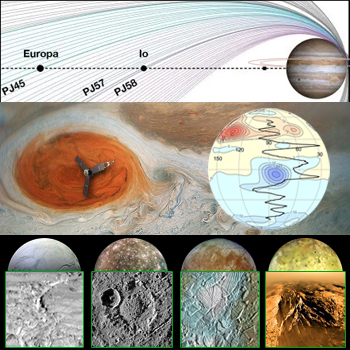Juno to Surpass 6 Full Years at Jupiter, Speeding Toward Europa Close Flyby
|
MONDAY☆ Jul 4 — ISS, ~405-km LEO: Expedition 67 seven-member crew (3 NASA, 3 Roscosmos, 1 ESA) tending radish sprouts for XROOTS hydroponic / aeroponic study, maintaining Intelligent Glass Optics study on AI processing, conducting human research on radiation and immunity. ☆ Jul 4 — Tiangong Space Station, ~370-km LEO: Shenzhou 14 three-member crew working to configure and test optical atomic clock with goal of one quintillionth / second accuracy, Shenzhou-13 crew ‘feeling good’, recount toenail clipping travails. Highlights… o NewSpace: Ohio State University analyzing in-space manufactured product (2-g potassium dihydrogen phosphate sample acquired from Redwire for US$4k) for defects; SpaceX preparing Super Heavy B7 for static fire testing on Boca Chica launchpad, supported by ‘chopstick’ robotic arms. ☆ Solar System: LRO investigating double crater on Moon near Hertzsprung crater presumed to have been created by LM-3C rocket impact; CNSA to release 1,040 GB of Tianwen-1 Mars data internationally, considering Neptune mission powered by 10 kWe fission reactor. ☆ Galaxy: Leibniz Institute for Astrophysics Potsdam model elucidates galaxy formation / IR and radio radiation release; International team utilizing SOFIA and Herschel Space Telescope data reveal ‘missing’ intergalactic medium metals. o Global: Institute of Biomedical Problems of RAS & NASA Human Research Program planning SIRIUS-22/23 after completion of 240-day analog mission SIRIUS-21; 100-kg e THEOS-2 SmallSAT, developed via 4-year Surrey training program, in transit to Thailand space agency GISTDA. ● USA: ICESat-2 to continue work mapping Antarctic ice volume past nominal 3-year mission end; Black In Astro Community working to increase black representation in academic Astronomy; MIT researchers propose stationing silicon ‘bubbles’ at Sun-Earth L1 to deflect 1.8% of solar radiance. ● Hawai’i: Hōkū Keʻa Observatory ready for decommissioning after UH completes Final Environmental Assessment; New Mauna Kea Stewardship and Oversight Authority establishment certain as Governor Ige announces he will not veto HB2024. |
 |
● = Terrestrial events, and…
o = International terrestrial events in local time. ★ = Space events, and… ☆ = International space / astro events in Hawaii Standard Time unless noted. Add 10 hours to obtain UT (‘Universal Time’). |
Weekly Planet Watch – Morning Planets: Venus (ENE), Mars (ESE), Jupiter (ESE), Saturn (S), Uranus (E), Neptune (SE).
Vega C Inaugural Launch Set for July 7 as Europe Advances Space Commercialization, Art and Science
|
★ Jul 4 — Juno, Jupiter Orbit: Spacecraft reaches 6th full year at Jupiter today; one-way transmission signal to Earth is 48 minutes, mission extended through September 2025. ☆ Jul 4 — NASA, Equatorial Launch Australia, Launch Black Brant 9 / Suborbital Imaging Spectrograph for Transition region Irradiance from Nearby Exoplanet (SISTINE), Arnhem Space Center, Yolngu land, Australia: Magellan Aerospace sounding rocket launching suborbital astrophysics mission SISTINE to study stellar UV effects on atmospheric gases associated with biosignatures, led by Univ of Colorado Boulder. o Jul 4 — ESA, European Space Policy Institute, Hybrid / Vienna, Austria and Online: European Centre for Space Economy and Commerce (ECSECO) launch event; new organization with ESPI as secretariat to be discussed, 14:00-16:00 CEST. o Jul 4-8 — University of Oxford, Oxford, United Kingdom: Rocky Worlds II Conference. ☆ Jul 4 — Apollo Asteroid 2022 LX1: Near-Earth Flyby (0.076 AU) Continued From… ★ Jun 28 – Nov 13 — CAPSTONE, Near-Rectilinear Halo Orbit Trajectory: Cislunar Autonomous Positioning System Technology Operations and Navigation Experiment heading to operating position at NRHO / cislunar space. TUESDAYo Jul 5 — KARI, Incheon International Airport, S Korea: South Korea lunar orbiter ‘Danuri’ to be sent on its way to Cape Canaveral SFS today for August 5 launch. ● Jul 5 — The Space Show, Online / Tiburon CA: Dr. David Livingston talks with space historian Bob Zimmerman. o Jul 5-16 — Moscow Institute of Physics and Technology (MIPT), P. N. Lebedev Physical Institute (LPI), Moscow, Russia: 16th Summer School of Modern Astrophysics (SOMA-2022): Exoplanets – Formation and Evolution; Cancelled. ☆ Jul 5 — Amor Asteroid 2022 MY: Near-Earth Flyby (0.033 AU) ☆ Jul 5 — Aten Asteroid 2021 EL4: Near-Earth Flyby (0.050 AU) ☆ Jul 5 — Apollo Asteroid 2022 MA1: Near-Earth Flyby (0.054 AU) |
WEDNESDAY
☆ Jul 6 — Mercury: 0.86° S of M35 cluster, 02:00.
THURSDAY
☆ Jul 7 — Arianespace, Launch Vega C / LARES 2, Kourou, French Guiana: Inaugural flight of Vega C with LARES 2 satellite for ASI, Italian Space Agency for geodynamics and general relativity research.
★ Jul 7 — SpaceX, Launch Falcon 9 / Starlink 4-21, LC-39A, KSC FL: Another batch of Starlink satellites to be launched, first stage booster to land on drone ship in Atlantic Ocean.
o Jul 7-9 — Space Renaissance International, Berlin, Germany and Online: Space Renaissance Art & Science Festival 2022.
☆ Jul 7 — Moon: At first quarter, 16:14; 4.4° NNE of Spica, 10:00.
FRIDAY
★ Jul 8 — SpaceX, Launch Falcon 9 / Starlink 3-1, SLC-4E, Vandenberg SFB CA: Batch of Starlink satellites to be launched into a new shell at an inclination of 97.6 degrees (Starlink to have 5 shells total), first stage booster to land on drone ship in Pacific Ocean.
☆ Jul 8 — Apollo Asteroid 2020 GE: Near-Earth Flyby (0.062 AU)
SATURDAY
● Jul 9 — AIAA LA-LV Section, Hybrid / Lawndale CA and Online: AIAA LA-LV Section Town Hall Meeting; also featuring ‘The Upcoming Europa Clipper Mission’ by Dave Doody, Space Flight Operations Engineer, 11:00 PDT.
☆ Jul 9 — Apollo Asteroid 2022 MX: Near-Earth Flyby (0.086 AU)
SUNDAY
☆ Jul 10 — Mercury: At perihelion, 0.3075 AU from Sun, 12:00.
☆ Jul 10 — Moon: 2.90° NNE of Antares, 16:00.

